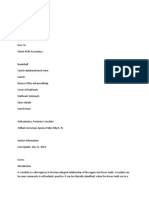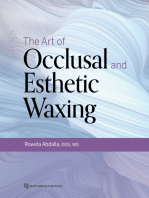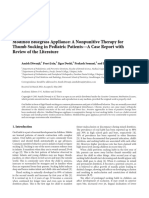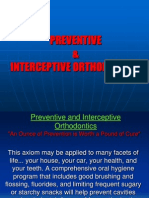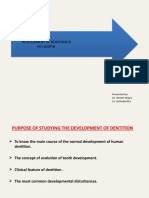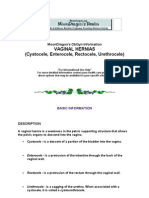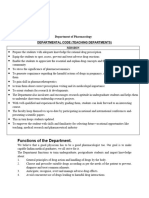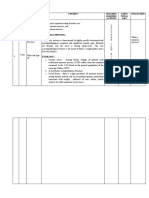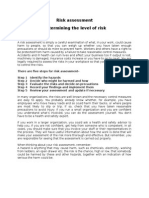100%(1)100% found this document useful (1 vote)
992 viewsSpace Management
Space Management
Uploaded by
dr parveen bathlaThis document discusses various methods for regaining space lost due to early loss of primary teeth, including fixed and removable appliances. It emphasizes the importance of a thorough diagnosis to assess dental alignment, arch needs, and skeletal relationships before attempting space regaining. Specific appliances discussed include a simple fixed retainer using a molar band and wire to reposition a distally drifted bicuspid, the Jaffe appliance using springs between molar bands and a sliding arch, and the Gerber space maintainer fabricated directly in the mouth using a band, welded tube, and wire assembly with optional springs.
Copyright:
© All Rights Reserved
Available Formats
Download as DOCX, PDF, TXT or read online from Scribd
Space Management
Space Management
Uploaded by
dr parveen bathla100%(1)100% found this document useful (1 vote)
992 views11 pagesThis document discusses various methods for regaining space lost due to early loss of primary teeth, including fixed and removable appliances. It emphasizes the importance of a thorough diagnosis to assess dental alignment, arch needs, and skeletal relationships before attempting space regaining. Specific appliances discussed include a simple fixed retainer using a molar band and wire to reposition a distally drifted bicuspid, the Jaffe appliance using springs between molar bands and a sliding arch, and the Gerber space maintainer fabricated directly in the mouth using a band, welded tube, and wire assembly with optional springs.
Original Description:
space management
Copyright
© © All Rights Reserved
Available Formats
DOCX, PDF, TXT or read online from Scribd
Share this document
Did you find this document useful?
Is this content inappropriate?
This document discusses various methods for regaining space lost due to early loss of primary teeth, including fixed and removable appliances. It emphasizes the importance of a thorough diagnosis to assess dental alignment, arch needs, and skeletal relationships before attempting space regaining. Specific appliances discussed include a simple fixed retainer using a molar band and wire to reposition a distally drifted bicuspid, the Jaffe appliance using springs between molar bands and a sliding arch, and the Gerber space maintainer fabricated directly in the mouth using a band, welded tube, and wire assembly with optional springs.
Copyright:
© All Rights Reserved
Available Formats
Download as DOCX, PDF, TXT or read online from Scribd
Download as docx, pdf, or txt
100%(1)100% found this document useful (1 vote)
992 views11 pagesSpace Management
Space Management
Uploaded by
dr parveen bathlaThis document discusses various methods for regaining space lost due to early loss of primary teeth, including fixed and removable appliances. It emphasizes the importance of a thorough diagnosis to assess dental alignment, arch needs, and skeletal relationships before attempting space regaining. Specific appliances discussed include a simple fixed retainer using a molar band and wire to reposition a distally drifted bicuspid, the Jaffe appliance using springs between molar bands and a sliding arch, and the Gerber space maintainer fabricated directly in the mouth using a band, welded tube, and wire assembly with optional springs.
Copyright:
© All Rights Reserved
Available Formats
Download as DOCX, PDF, TXT or read online from Scribd
Download as docx, pdf, or txt
You are on page 1of 11
At a glance
Powered by AI
The text discusses the importance of space maintenance following early loss of primary teeth to prevent occlusal disharmonies. A thorough diagnosis considering dental, skeletal and soft tissue relationships is necessary before attempting to regain space. Study models, radiographs and clinical assessments should be utilized.
The text lists several factors that should be considered for diagnosis including the alignment and space needs of other teeth, relationships to the denture bases and cranium, and soft tissue profile. Assessments of dental tipping versus bodily movement and the impacts of adjacent teeth are also important.
The text states that study models, radiographs, clinical assessments of facial symmetry and proportions, and possibly cephalometric analysis are necessary diagnostic aids to develop a database for space considerations.
REGAINING THE SPACE
Space maintenance is necessary in early loss of posterior primary teeth because
early loss contributes to the development of occlusal disharmonies. However
when space is progressively lost, as we have discussed in space closures following
early loss of primary teeth, the therapy should be considered to regain it so that
additional disharmonies do not develop. Then the regained space is maintained.
DIAGNOSIS
For regaining space or any movement of teeth, the most important procedure is
the diagnosis. The attention is not limited to the segment in which tooth is missing
is a frequent cause of failure in attempting to regain space. Considerations for
treatment should include the alignment and space needs of other teeth in the arch,
the relationships of teeth to the denture base, the transverse and sagittal dental
relationships, the vertical denture relationships, the skeletal relationships of the
denture bases to the cranium, and the profile of the soft tissue. The diagnostic aids
necessary to develop a database for the above consideration include study models,
radiographs of all the periapical structures, clinical assessment of facial symmetry
and proportions, and possibly cephalometric analysis.
Clinically we have to make quick assessments to determine unfavourable skeletal
patterns or dental malocclusions. When the clinical assessment has ruled out the
presence of a dental or skeletal class II, class III, openbite or closed bite
relationship, there may still exist variations in the Class I malocclusion in which
simple measures at regaining space should not be the only consideration.
Assessment of soft tissue profile will help to identify cases in which relative
protrusion or retrusion of the dental alveolar structures does complicate evaluation
of available space. Correction of protrusion or retrusion will require more than
simple regaining of space.
Radiographs and study models will aid significantly in assessing space needs and
consideration of tooth alignment. It is important to recognize whether teeth have
moved bodily into the space or have tipped axially because forces applied to tip
teeth back into a proper alignment are easier to manage than force required to
bodily return tooth to their proper position in the arch. Another component of data
base requires visualizing the proximity of adjacent erupting teeth (especially
second molars) and estimating their potential impact on the teeth that have
crowded the space. Radiographs of the periapical structures are necessary.
Dental alignment consideration that affect the regaining of space include
estimation of rotation, slipped contacts, and facial-lingual displacement of teeth
from arch circumference. Study models will provide the best data resource for
these considerations. For example, loss of space in the incisor segment owing to
rotation and overlapping contacts can be estimated and placed on the models
before assessing the amount of space loss in a molar segment. Study models
permit visualization of vertical, transverse and sagittal dental relationship that
might hinder stability of Moyers mixed dentition analysis will be a good aid to
determine measurement of space loss against an estimation of the space needed by
the unerupted permanent tooth. Moyers analysis is easy to apply for both early
and late mixed dentition problems. Estimations based on radiographs demonstrate
variance because of difficulties in standardized film placement, especially in the
small mouth of the child with early mixed dentition.
Several problems are associated with the regaining procedures. Usually minimal
space loss can be regained better. The space regaining procedure that involves
tipping of first permanent molar can be accomplished more easily in the maxillary
arch than in the mandibular arch. The procedure should be limited to those cases
in which the occlusion is Class I, there is adequate anchorage, the second
permanent molar is unerupted and there is favourable relationship of the second
permanent molar with the first permanent molar.
When appliance are used to position first permanent molars, there will be
reciprocal force exerted to the teeth and supporting tissues anterior to the space
and the result may be an undesirable flaring of the anterior teeth. This particularly
occurs during the mixed dentition period when the permanent incisors are
incompletely erupted and adversely influenced by even minimal forces.
Furthermore, the forward movement of the unerupted, second permanent molar
accompanies the forward movement of first molar, and any attempt to tip or
reposition the first permanent molar may produce an impaction of the second
molar.
If favourable conditions exists, an attempt to regain space is certainly indicated.
Several fixed and removable appliances for space regaining procedures were
evolved i.e. tipping of the first molars. However, the distal movement other than
minimal tipping can most satisfactorily achieved by head gear appliance.
FIXED SPACE REGAINERS
CONSTRUCTION OF A SIMPLE APPLIANCE TO REPOSITION THE
DISTALLY POSITIONED BICUSPID:
Fred Ehrlich (1950) stated that if the first premolar has already erupted and drifted
distally, a reciprocal active fixed regainer can be used to good advantage in the
mandibular arch. A molar band is fitted to the first permanent molar. Molar tubes
are soldered or spot welded in a horizontal position both buccally and lingually to
the band. Impressions will be taken with alginate. The tubes will furnish enough of
the undercut to lock the band into the impression material while vibrating the
stone mix. Make sure you put some wax in the tubes before seating the band in the
impression.
A stainless steel wire which is slightly smaller than the tube size is selected and
bent in a U shape. The base of the U should contain a reverse bend to contact
the distal surface of the first premolar. As the wire comes out of the tube it should
aim toward the first premolar at a point just below the greatest distal convexity of
the first premolar. A stop should be placed on both arms where the straight part
meets the bend of the wire and is cut about (2 to 3mm) longer than the distance
from the anterior stop to the molar tube. When all these parts are ready the band is
removed from the working model by heating the stone molar and plunging it into
water. The friable stone residue can easily be removed by scraping and cutting
with a laboratory knife. Then the parts are cleaned, assembled and the band is
cemented with coil springs compressed between the stop and molar tube once in
place, the reciprocal action of the coil spring will upright the premolar readily,-
and the molar somewhat. If the diagnosis la correct and the treatment plan has
been carried out quickly enough, room for the second premolar is regained,
provided there really was room for it.
JAFFE APPLIANCE
An appliance for certain minor tooth movements was described by Paul E. Jaffe
(1963), is useful when the presence of ankylosed tooth, early loss of a deciduous
molar or an extraction result in filling of adjacent segments into proximal dental
area. Movement is obtained by the use of light spring pressure against a sliding
section or arch. The appliance consists of buccal and lingual arms with a sliding
arch section. Springs are used in between soldered part of the buccal and lingual
arms of molar bands and the sliding arch to move the desired tooth or teeth.
GERBER SPACE MAINTAINER
This type of appliance may be fabricated directly in the mouth during one
relatively short appointment and requires no lab work. A seamless Orthodontic
band or crown is selected for the abutment tooth and fitted, and the mesial surface
is marked for placement of U" assembly, which may be welded or soldered in
place with silver solder and fluoride flux. The wire "U" section is fitted in the
tube, the appliance placed and wire section extended to contact the tooth mesial to
the edentulous area. A marking file or pencil' is used to establish proper position.
Assembly is removed and welded or soldered at this point (upper right).
Expanded center and lower left views .show occlusal rest added to wire section to
reduce cantilever effect. If appliance is to be used as a spring-loaded space
retainer, tube and wire "U" assembly are not Welded. An eyelet -may be welded to
an flattened part of the tube next to the band weldable tube stops are soldered on
wire portion (lower right) and open coil spring sections are cut to fit over wire
between "Stops" and ends of "U" tube. The length of push coil springs Is
established by placing the band-tube-wire assembly in the mouth, extending the
wire to the desired length, in contact with the mesial tooth and measuring the
distance between the tube stops on the wire and the end of the "U" tube. To this
distance, add the amount of space needed in the regainer, plus 1 to 2 m, to
ensure spring activation and cut springs to this length. Load springs, tie floss
or steel ligature through eyelet and over "U wire to hold stored force in
compressed spring. Be sure to compress springs enough to allow the assembly to
fit the edentulous area. After cementation cut the ligature and remove to activate
regainer.
HOTZ LINGUAL ARCH
Another method for moving molar distally utilizes the looped Hotz lingual
(Hitchcock 1974). This is appropriate in a situation where the lower first
permanent molar has drifted mesially, out the premolar or cuspid has not drifted
distally. But there must be Xray evidence that there is sufficient space between
first molar and developing second molar.
The lingual arch provides compound anchorage from all the other teeth which the
lingual arch touches. A horizontal spur can be soldered perpendicular to the arch
wire contacting the distal surface of the premolar or canine. This compounds the
anchorage additionally. The loop on the active side is adjusted periodically (once a
month). After adjustment, the posts in the passive position should be
approximately 1mm distal to their passive positions over the lumen of their tubes.
The arch is then forced forward and the posts slipped down into place.
KING APPLIANCE:
King (1977) described an appliance for regaining of space in both maxillary and
mandibular arch. The anchorage unit for the mandibular arch is basically a fixed
lingual arch with bands fitted on the first deciduous molar of the treatment side
and the first permanent molar on the opposite side. Then a wide siamose edgewise
bracket is spot welded to the buccal surface of the primary molar band, and the
completed anchorage unit is cemented in place. A band with an angulated buccal
tube is cemented on the malpositioned molar, and a straight section of wire with
an open coil spring is introduced into the buccal tube and ligated into the bracket.
The anchorage unit must be modified for the treatment in the maxillary arch. A
millimeter a month is satisfactory progress in the repositioning of first molar.
When a Class I or cusp to cusp molar relation is achieved, a conventional space
maintaining appliance should be given.
A SECTIONAL ARCH TECHNIQUE TO REGAIN SPACE:
Tinginys (1978) presented a sectional arch technique to regain lost arch length.
Upto 4 millimeters of space can be regained in an effective and efficient manner
by the method described.
It can be used in the cases where the second molar is erupted-------.
Direct technique:
The cuspid, bicuspid and first molar teeth are banded with edgewise buccal
brackets and lingual buttons. The edgewise brackets should have the necessary
torque built in as this simplifies treatment. The first sectional arch wire is 0.016
inch diameter.
After two months a 0.020 arch wire is inserted with the same design as the 0.016.
After three to four months. 10.018 x 0.025 rectangular sectional arch is placed.
This is the final arch wire and acts as a retainer while waiting for the premolar to
erupt, which may take as long as six to eight months. Only a large loop is
necessary in this wire.
When the arch wire is tied in place with the ligature wire, the force will be to tip
the molar distally and intrude the cuspid and first bicuspid. The location of the
second molar is important. If it is unerupted, then tipping the first molar distal may
impact it. Radiographs should be taken to forsee this potential problem.
The presence of an erupted second molar is not a contraindication to treatment. A
spring separator can be inserted between the first and second molars, as this
prevents friction and binding and facilitates tooth movement.
The archwire should follow the contour of the distal arch in order to prevent
buccal movement of the cuspid and first bicuspid. The lingual buttons on the
cuspid and ---------- be tied together with 0.010 ligature wire to provide more
stability to the anchor teeth. Adjustments at the circle of the arch are made at
monthly intervals. If the second premolar erupts rotated, it must be banded by
using lingual buttons, buccal brackets and elastic ligature so that it can be correctly
aligned.
Indirect technique:
The teeth are separated and an alginated impression taken. An orthodontic
laboratory can adapt bands with torqued edgewise brackets and lingual buttons on
the study model.
Other types of fixed space regainers will include head gear appliance used for
maxilla, lip bumper used for mandible. These are the interceptive appliances
which are used when second permanent molar is already erupted into the oral
cavity. These were not discussed in this topic.
ANTERIOR SPACE REGAINER:
Bayardo (1986) described an anterior space regainer utilizing direct bonding
technique.
A four year old boy presented, with a maxillary primary right central incisor
missing, extracted four months earlier. The space was partially lost and the
anterior teeth had drifted to the space.
After prophylaxis two 0.018 x 0.025 standard labial tubes were adapted into the
mouth. A stainless steel mesh was spot welded and trimmed to the tubes.
The enamel of the labial surfaces of left central and right lateral incisors was
etched with 35% phosphoric acid and each labial tube was individually bonded to
each abutment tooth. When the composite polymerized, a piece of 0.014 standard
round wire was introduced into the lateral incisor tube. The wire was then inserted
in a 0.036 x 0.009 open coil spring previously selected, and passed through the
labial tube of the central incisor. A distal bend was made 2mm from the distal ends
of the tube.
After three weeks, the coil spring was activated and after the space was slightly
overwidened, a 0.016 round wire was inserted with the same coil spring. Three
weeks later the wire was changed to a 0.018 and finally to a 0.018 x 0.025
wire, leaving the coil spring only for retention.
Five weeks later, an acrylic pontic was fixed over the wire and coil spring, using
the same type of composite already in the patients mouth.
REMOVABLE SPACE REGAINERS
William G. Goodale (1957) described three types of removable space regainers.
FREE END LOOP SPRING SPACE REGAINER
It utilizes a labial archwire for stability and retention, with a back-action loop
spring constructed of No. 0.025 wire. The base of the appliance is made of acrylic
resin. Movement of the permanent molar is achieved by activating the free end of
the wire loop at certain intervals of time. A light force on the tooth to be moved is
desired. The appliance should be checked and adjusted as often as necessary to
maintain the light force on the molar. The type of loop spring wire can be changed
to fit any situation, depending on the position of the tooth and the distance it needs
to be moved.
A free-end loop space regainer for the lower arch has a shorter wire loop, resulting
in less distortion when the child inserts the appliance.
SPLIT-BLOCK SPACE REGAINER:
It is also called split saddle space regainer. It differs from the free end spring type
in that the functional part of the appliance consists of an acrylic block that is splti
buccolingually and jointed by No. 0.025 wire in the form of a buccal and a lingual
loop. The appliance is activated by periodic spreading of the loops. The activator
block is split with a disk after the appliance has been processed. The activator
portion of the split block appliance is essentially the same as one that has been
designed to establish space for fixed bridge therapy. The unilateral type used for
adults should not be used in the childs mouth, however because of the risks of
loss of swallowing.
FIXED, LOOP-SPRING SPACE REGAINER
It differs from other types only in the design of the spring activation. This
appliance resists breakage and provides a satisfactory method of moving the molar
distally. The mesial portion of the spring loop is embedded in the resin and passed
out through the edentulous space. This portion of wire should contact the distal
surface of the tooth which is mesial to the space. This prevents distal movement of
this tooth. A loop is then formed and the wire returned back to contact the mesial
surface of the first permanent molar. At this end, the wire is bent around a stable
embedded in the resin. The spring loop should be allowed to move freshly on the
staple. Retention of this appliance is gained by the use of wire clasps. Orthodontic
wire of No. 0.025 or No. 0.030 dimension is embedded in the acrylic resin,
brought through the embrasure and then bent down to contact the teeth below the
contact points. After the desired movement of the permanent molar has been
attained, the appliance may be used as a space maintainer by soldering the
activator portion of the spring to the guide wire in its passive position, or by filling
in the edentulous region with additional resin.
SLING SHOT SPACE REGAINER:
This consists of a wire elastic holder with hooks instead of wire spring that
transmits a force against the molar to be distalized. This is called sling shot
appliance, since the distalizing force is produced by the elastic streatched on the
middle of the lingual surface of the molar to be moved. The other is arranged in
the same position on the buccal surface of the molar.
The child places a new elastic between the hooks while the appliance is outside the
mouth. It is slipped into place then the childs fingers can guide the elastic into
place snugly against the gingival on the mesial margin of the molar to be
distalized. The elastic can be changed once each day.
SPACE REGAINER UTILIZING JACK-SCREW
It is another type of removable appliance used for space regaining which will
incorporate an expansion screw in the edentulous space. Space is opened by
expanding the plates anteroposteriorly.
RECALL AND FOLLOW-UP TREATMENT
As we have discussed earlier space maintenance is a dynamic process and should
be evaluated continuously. We should not take it granted that we have given the
appliance and it will take care of everything.
Patient should be recalled for every 2 to 3 months for checkup.
If the appliance is of removable type, we should check whether the patient is using
it or not, whether there is any distortion or breakage of the appliance or irritation
of soft tissues. If the teeth are emerging underneath the appliance the portion of
the acrylic is cut off to give way for the teeth to erupt into position.
In case of fixed appliances, we have to check for any breakage of the appliance at
the soldered joints or band material. It is also checked that whether the appliance
is loose due to dissolution of cement which may result in food lodgement and
caries.
The appliance is removed every 6 months or one year depending on the situation
and the abutment tooth is checked for any caries or decalcification. Polishing of
the abutment is done followed by fluoride application. Then the appliance is
recemented in position.
Regular radiographic examination of developing permanent teeth is also
necessary.
The appliance can be removed or discarded soon after the succedaneous teeth
erupted into proper position in the oral cavity so that there will not be
RESPONSIBILITY OF DENTIST/PEDODONTIST FOR MAINTENANCE
We have discussed about factors influencing space premature loss of primary
teeth, maintenance of .
This indicates that we are obligated to inform as well as their parents concerning
the possibilities in the event of an early loss of a primary tooth.
Parents may ask later in many instances, why -------- discuss the possibility of
closure of space at the ---------- tion?. We cannot defend ourselves by saying that
was not available in our office, or it was our opi--------- that the parent could not
afford to have an appliance------ fact that the dentist accepted the patient and
problems to the responsibilities incident to the treatment arrens the ----- that such a
dentist was negligent profesiionals. The practitioner who has informed and
adviced the parent childs complete dental needs does not share the research
incident to the development of a malocclusion.
In presenting the problem of space maintenance --- the parent the actual condition
existing in the challenging well as present the possibilities of a future
malocclusion pictures, roentgenograms; and models. The dentist is the parent why
such an appliance is essential, frequently hear the mother or father say. Well I ll
just walhappens, or x cant afford such a bridge in my chi----- this time.
The exact decision, reached by the dentist and the patient always should be
recorded for future reference. Fathers and mothers easily forget their statements
and conclusions of a year or two ago, and when the child returns to office with a
malocclusion, the result of an early extraction, the records should indicate the
decision made. The major offence was committed by the practitioner if this
problem was not discussed with the parent at the time of extraction or shortly
thereafter.
You might also like
- Anth 60666@Document5 pagesAnth 60666@anth60666100% (1)
- Final Year TipsDocument29 pagesFinal Year TipsWhalien 52No ratings yet
- Toronto Notes DermatologyDocument52 pagesToronto Notes Dermatologyalphabeta101100% (1)
- Avulsion of Primary Tooth-Modifi Ed Essix Retainer As A Space MaintainerDocument2 pagesAvulsion of Primary Tooth-Modifi Ed Essix Retainer As A Space Maintainernecrosis pulpNo ratings yet
- Crossbite PosteriorDocument11 pagesCrossbite PosteriorrohmatuwidyaNo ratings yet
- Normal Occlusion: Presented By: DR Ghulam RasoolDocument41 pagesNormal Occlusion: Presented By: DR Ghulam RasoolAbdul MohaiminNo ratings yet
- Orthodontically Driven Corticotomy: Tissue Engineering to Enhance Orthodontic and Multidisciplinary TreatmentFrom EverandOrthodontically Driven Corticotomy: Tissue Engineering to Enhance Orthodontic and Multidisciplinary TreatmentFederico BrugnamiNo ratings yet
- 11.moderate Nonskeletal Problems in Preadolescent ChildrenDocument11 pages11.moderate Nonskeletal Problems in Preadolescent ChildrenyasmineNo ratings yet
- Modified Bluegrass Appliance PDFDocument4 pagesModified Bluegrass Appliance PDFRenieKumalaNo ratings yet
- Use of Laser Systems in OrthodonticsDocument8 pagesUse of Laser Systems in OrthodonticsCatherine NocuaNo ratings yet
- Pedo SeminarDocument29 pagesPedo SeminarNency JainNo ratings yet
- Leeway Space of NanceDocument11 pagesLeeway Space of NanceGauriNo ratings yet
- Bioengineering Principles in Orthodontics / Orthodontic Courses by Indian Dental AcademyDocument165 pagesBioengineering Principles in Orthodontics / Orthodontic Courses by Indian Dental Academyindian dental academyNo ratings yet
- 3.retention RelapseDocument40 pages3.retention RelapseMohamed Yosef Morad100% (1)
- Methods of Gaining SpaceDocument25 pagesMethods of Gaining SpaceMaitreyi LimayeNo ratings yet
- Retention and RelapseDocument59 pagesRetention and RelapseAshwin Thejaswi100% (1)
- Nasoalveolar Moulding / Orthodontic Courses by Indian Dental AcademyDocument84 pagesNasoalveolar Moulding / Orthodontic Courses by Indian Dental Academyindian dental academyNo ratings yet
- Nance Vs TPADocument6 pagesNance Vs TPAAna Paulina Marquez Lizarraga0% (1)
- Role of A Pedodontist in Cleft Lip and Cleft Palate Rehabilitation - An OverviewDocument25 pagesRole of A Pedodontist in Cleft Lip and Cleft Palate Rehabilitation - An OverviewIJAR JOURNALNo ratings yet
- Open BiteDocument14 pagesOpen Biteفاطمة فالح ضايف مزعلNo ratings yet
- Preventive OrthodonticsDocument14 pagesPreventive OrthodonticsVaisakh Ramachandran0% (1)
- Ret and RelapseDocument78 pagesRet and RelapseDeepshikha MandalNo ratings yet
- 27277-Article Text-98440-1-10-20160406Document6 pages27277-Article Text-98440-1-10-20160406ismyar wahyuniNo ratings yet
- 1 Orthodontic Consiations of Impacted TeethDocument32 pages1 Orthodontic Consiations of Impacted TeethDivya SoniNo ratings yet
- Preventive & Interceptive OrthodonticsDocument50 pagesPreventive & Interceptive OrthodonticsDeebah ChoudharyNo ratings yet
- Abo Clinical Exam Study GuideDocument15 pagesAbo Clinical Exam Study GuidealrowdhidentalNo ratings yet
- Tooth Eruption and Its Disorders - Pediatric DentistryDocument157 pagesTooth Eruption and Its Disorders - Pediatric DentistryPuneet ChoudharyNo ratings yet
- Orthognathic DR Shruthi PDFDocument54 pagesOrthognathic DR Shruthi PDFShruthee KNo ratings yet
- CDE Fundamentals - in - Tooth - Preparation 16 12 14Document87 pagesCDE Fundamentals - in - Tooth - Preparation 16 12 14Saad khanNo ratings yet
- Groper's ApplianceDocument4 pagesGroper's Appliancejinny1_0No ratings yet
- Orthodontics rs3Document17 pagesOrthodontics rs3Madiha ZufaNo ratings yet
- OcclusionDocument49 pagesOcclusionزياد حميد رشيدNo ratings yet
- Development of Dentition & OcclusionDocument109 pagesDevelopment of Dentition & OcclusionSyed Mohammad Osama Ahsan100% (1)
- Space RegainerDocument7 pagesSpace RegainerdelfNo ratings yet
- Presurgical Infant Orthopedics For Cleft Lip and PDocument6 pagesPresurgical Infant Orthopedics For Cleft Lip and PPark JiminNo ratings yet
- Space Regainers in Pediatric DentistryDocument6 pagesSpace Regainers in Pediatric DentistryDiba Eka DiputriNo ratings yet
- Shaivy JC 5THDocument42 pagesShaivy JC 5THMehrZohairNo ratings yet
- Cephalometric Lecture-2Document64 pagesCephalometric Lecture-2Batman 02053No ratings yet
- Cleft Lip and Palate in Paediatric DentistryDocument29 pagesCleft Lip and Palate in Paediatric DentistryAkshay Sreeraman KecheryNo ratings yet
- Crowding 180601115625 PDFDocument109 pagesCrowding 180601115625 PDFVishal SharmaNo ratings yet
- Case Report Class III Orthodontic Camouflage: Is The "Ideal" Treatment Always The Best Option? A Documented Case ReportDocument7 pagesCase Report Class III Orthodontic Camouflage: Is The "Ideal" Treatment Always The Best Option? A Documented Case ReportDany PapuchoNo ratings yet
- Dentin Pulp ComplexDocument41 pagesDentin Pulp ComplexKelly YeowNo ratings yet
- Age Factor in OrthodonticsDocument4 pagesAge Factor in OrthodonticsNeeraj Arora100% (1)
- Goal of IsolationDocument20 pagesGoal of IsolationShivangiJainNo ratings yet
- Developmental DisordersDocument36 pagesDevelopmental DisordersANJINo ratings yet
- Biocompatibility Associated With Orthodontic Materilas-M.M.varadharajaDocument103 pagesBiocompatibility Associated With Orthodontic Materilas-M.M.varadharajaavanthika krishnarajNo ratings yet
- Diagnosis ClassDocument63 pagesDiagnosis ClassRiham AliNo ratings yet
- Growth Assessment ParametersDocument97 pagesGrowth Assessment ParametersAurthi ElamparithiNo ratings yet
- Nutrition and MalocclusionDocument2 pagesNutrition and Malocclusionsrishti jainNo ratings yet
- Post Dam AreaDocument2 pagesPost Dam ArearazasiddiqueNo ratings yet
- Preappointment BehaviorDocument2 pagesPreappointment BehaviorewretrdfNo ratings yet
- Development of Occlusion (Seminar 1)Document47 pagesDevelopment of Occlusion (Seminar 1)Isha GargNo ratings yet
- CLASPS 1 / Orthodontic Courses by Indian Dental AcademyDocument53 pagesCLASPS 1 / Orthodontic Courses by Indian Dental Academyindian dental academyNo ratings yet
- Biological Properties of Dental Materials 1-General Dentistry / Orthodontic Courses by Indian Dental AcademyDocument76 pagesBiological Properties of Dental Materials 1-General Dentistry / Orthodontic Courses by Indian Dental Academyindian dental academyNo ratings yet
- Biological Restorations in Children: January 2016Document4 pagesBiological Restorations in Children: January 2016Mel LlerenaNo ratings yet
- Matrix Band PlacementDocument8 pagesMatrix Band PlacementEllizabeth LilantiNo ratings yet
- Nanotechnology and Its Application in DentistryDocument7 pagesNanotechnology and Its Application in Dentistrydr parveen bathlaNo ratings yet
- Early Childhood Caries - A Review PDFDocument7 pagesEarly Childhood Caries - A Review PDFdr parveen bathlaNo ratings yet
- Essential Functions of Public HealthDocument1 pageEssential Functions of Public Healthdr parveen bathlaNo ratings yet
- G PeriodicityDocument5 pagesG Periodicitydr parveen bathlaNo ratings yet
- G Periodicity PDFDocument8 pagesG Periodicity PDFTry SidabutarNo ratings yet
- Guidelines SHP 29th Jan 09-Final FinalDocument3 pagesGuidelines SHP 29th Jan 09-Final Finaldr parveen bathlaNo ratings yet
- Fluoride ContaminationDocument6 pagesFluoride Contaminationdr parveen bathlaNo ratings yet
- Oral Hygiene TipsDocument3 pagesOral Hygiene Tipsdr parveen bathlaNo ratings yet
- Post Core PDFDocument6 pagesPost Core PDFdr parveen bathlaNo ratings yet
- Treatment FluorosisDocument3 pagesTreatment Fluorosisdr parveen bathlaNo ratings yet
- Clean and Fresh: I Fact Sheet Oral Hygiene IDocument2 pagesClean and Fresh: I Fact Sheet Oral Hygiene Idr parveen bathlaNo ratings yet
- Re Attatch MentDocument3 pagesRe Attatch Mentdr parveen bathlaNo ratings yet
- 25-07-2021 - Handwritten NotesDocument19 pages25-07-2021 - Handwritten Notesraorane.swati27No ratings yet
- 1st Quarter Exam Mapeh 8 - CompressDocument4 pages1st Quarter Exam Mapeh 8 - CompressHanne UyNo ratings yet
- TGI Spring (April 2024)Document6 pagesTGI Spring (April 2024)The Livingston County NewsNo ratings yet
- Feasibility Studies For Construction ProjectsDocument12 pagesFeasibility Studies For Construction ProjectsLokuliyanaN100% (2)
- Highland Park Elementary - Lead Detected at or Above 15 PPBDocument4 pagesHighland Park Elementary - Lead Detected at or Above 15 PPBLeigh AshtonNo ratings yet
- Emission Testing and Standards in California: Updating Section 01350Document2 pagesEmission Testing and Standards in California: Updating Section 01350juli_radNo ratings yet
- Assessment 1st Quarter RemedialDocument14 pagesAssessment 1st Quarter Remediallouiseannecastro25No ratings yet
- Congruent or Authentic, and Who Unconditional Positive RegardDocument5 pagesCongruent or Authentic, and Who Unconditional Positive RegardRenz GarciaNo ratings yet
- Prescription Renewal Request - Electronic SystemDocument1 pagePrescription Renewal Request - Electronic SystemRishikeshNo ratings yet
- Pharmacy - Professional Regulation Commission Board of PharmacyDocument1 pagePharmacy - Professional Regulation Commission Board of PharmacyBas BaylonNo ratings yet
- Contact Lenses and Associated AnteriorDocument13 pagesContact Lenses and Associated AnteriorJose Antonio Fuentes VegaNo ratings yet
- Anger ManagementDocument53 pagesAnger ManagementSajidullah AnsariNo ratings yet
- Moon DragonDocument23 pagesMoon DragonFrederica AriestaNo ratings yet
- Deltopectoral Flap in The Era of MicrosurgeryDocument6 pagesDeltopectoral Flap in The Era of MicrosurgeryAngga Putra Kusuma KusumaNo ratings yet
- Fitness RX For MenDocument84 pagesFitness RX For MenRujichon Iamphattanatam100% (2)
- 1 My Capstone Projec1Document1 page1 My Capstone Projec1api-272474692No ratings yet
- Pharmacology Department Sop Standard Operating Procedures PDFDocument7 pagesPharmacology Department Sop Standard Operating Procedures PDFprasanbhandariNo ratings yet
- Lesson Plan On Eating DisorderDocument17 pagesLesson Plan On Eating DisorderAnkush Kulat PatilNo ratings yet
- Foldable Crutch MQP Final DraftDocument136 pagesFoldable Crutch MQP Final DraftPa VelNo ratings yet
- Risk Assessment Determining The Level of RiskDocument3 pagesRisk Assessment Determining The Level of RiskpoojaupesNo ratings yet
- Phrenic Nerve Palsy: A Rare Cause of Respiratory Distress in NewbornDocument5 pagesPhrenic Nerve Palsy: A Rare Cause of Respiratory Distress in NewbornIJAR JOURNALNo ratings yet
- Edema in ChildDocument16 pagesEdema in ChildKesava DassNo ratings yet
- Pan Literature ReviewDocument5 pagesPan Literature Reviewea0bvc3s100% (1)
- Distribution and Retrival Monitoring Sheet in ModulesDocument10 pagesDistribution and Retrival Monitoring Sheet in ModulesJenevey AlcoberNo ratings yet
- SSS MatDocument2 pagesSSS MatAndrea Tabisaura ToribioNo ratings yet
- Drug Information CentreDocument8 pagesDrug Information CentreAlizaNo ratings yet
- Charlene Resume 3021Document2 pagesCharlene Resume 3021api-242002271No ratings yet
- Optum: A Health Services and Innovation CompanyDocument2 pagesOptum: A Health Services and Innovation CompanySui NarcanNo ratings yet




